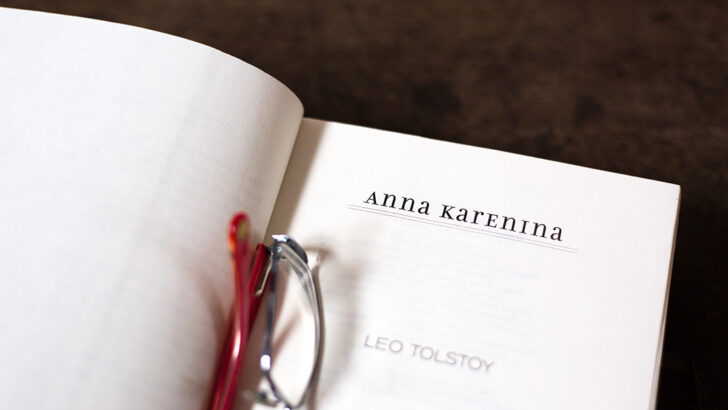In Leo Tolstoy’s famed novel, Anna Karenina, one of the main characters, Kitty, is heartbroken when the man she thought she was going marry, Count Vronsky, has designs on Anna instead. Kitty becomes listless and melancholic.
Kitty’s family bring her to a health spa in Germany to recover, which she finally does by befriending another young woman who is also at the spa with a sick companion. The spa is filled with the physically and mentally unwell.
In War and Peace, Natasha, the novel’s heroine, is heart-broken after she falls for a cad and is prevented from eloping with him. Her parents bring doctor after doctor to see her but none of them seem able to help. Finally, she recovers on her own. She throws off her listlessness and melancholy.
War and Peace was written in Russia in the 1860s and Anna Karenina in the 1870s but all the novels’ themes are timeless because human nature is timeless. People always were and always will be subject to setbacks and periods of melancholy. Kitty and Natasha’s parents are rich enough to seek professional help when their daughters suffer setbacks. Poor families had to make do.
Epidemic
Today, there seems to be an epidemic of depression and anxiety among young people, even school-children, and today a lot more parents are in a position to seek professional help for their children, and even when parents cannot afford it, perhaps they can turn to the public health system instead.
One way or another we have seen a surge in diagnoses of anxiety, depression, ADHD, autism, and so on. The big question is whether there is a lot of over-diagnosis going on, or whether doctors and therapists are uncovering very widespread problems that have always been there but have previously been left undiagnosed and untreated.
Dr O’Sullivan worries that labelling a child like this might then teach them to lower expectations for themselves”
A number of books have been published lately that address precisely this question. One is called ‘Bad Therapy: Why the Kids Aren’t Growing Up’ by Abigail Shrier. Another is ‘The Age of Diagnosis’ by Dr Suzanne O’Connor, and a third one is ‘Searching for Normal: A New Approach to Understanding Distress and Neurodiversity’ by Sami Timimi.
None of the authors deny the reality of mental health problems, but all of them think there is also a lot of over-diagnosis and over-medicating taking place as well.
When children are not doing well in school or in life, parents understandably worry, and want to do something. They might want their child to receive additional help in school. The school itself might advise the parents to bring their child along for professional help. The child is then diagnosed with a particular problem. They might be told they suffer from depression, or from anxiety, or that they have ADHD (attention deficit hyperactivity disorder) or be mildly autistic and that is why they are very socially awkward and have few if any friends.
Dr O’Sullivan worries that labelling a child like this might then teach them to lower expectations for themselves.
Autism
In Britain the diagnosis of autism has surged by almost 800% between 1998 and 2018, that is, in only 20 years.
The child might then be put on some kind of medication and possibly remain on it for life, which is hugely profitable for the pharmaceutical companies.
O’Sullivan writes: “ADHD is a business as well as a medical disorder”. She says the continual medicalisation of the problems of life is part of an effort to find a “biological cause of human distress”.
No-one can deny, and these authors certainly do not, that is a genuine increase in the number of young people suffering from anxiety. The problem is particularly acute among teenage girls. Child psychologists report a huge rise in the number of girls who are self-harming.
Meanwhile, a lot of boys seem to be turning more aggressive. Recently, we read about the stabbing of an 11-year-old boy at a primary school in Dublin. More than half of school teachers have experienced physical aggression, according to a poll from the Irish National Teachers’ Organisation.
Girls turning their aggression and anxiety against themselves, and boys turning them against others is classically male/female stereotypical behaviour.
The rise of social media is obviously a contributory factor, as had been well catalogued by writers such as Jean Twenge and Jonathan Haidt”
There also seems to be a lot of social contagion going on, that is, anxiety is almost catching. You see anxious people all around you, and it makes you anxious. You almost think it is normal to be anxious. Young people begin to talk to each other about their mental health problems and the medications they are taking and the whole things becomes more normalised and self-perpetuating.
The rise of social media is obviously a contributory factor, as had been well catalogued by writers such as Jean Twenge and Jonathan Haidt.
For example, social media encourages you to constantly compare yourself with other people. It ‘turns on’ your brain rather than relaxes it. Whereas reading is meditative and calming, scrolling through social media is addictive and anxiety-inducing. The two things could hardly be more different. Lots of young people don’t read anymore.
In other words, we are creating the social conditions that lead to rising anxiety and other disorders. There is also something paradoxical going on; the more we highlight mental health, the worse it seems to get, and yet we feel obliged to raise it. What else can we do?
Does any of this have a spiritual dimension? It is very hard to believe it does not. Religion is the great provider of a sense of meaning and purpose. It gives life a transcendent focus by teaching that there is something above and beyond us. It gives us a strong sense of right and wrong. It encourages us to be other-focused, not self-focused. Prayer is meditative and it also encourages us to hand our problems over to God. Religion says that suffering and struggle are normal, not abnormal, and teaches us how to cope with them.
Religion
Religion has almost completely vanished from the lives of many young people. Sometimes it is replaced by ‘spirituality’ which can be good but can also be very vague and in its New Age forms too self-focussed.
But a lot of the time religion is simply replaced by overly materialistic and individualistic life goals, and these are not bringing peace of mind. That is the crux of the matter; a failure to find peace of mind. Modern life is making us anxious instead. The right kind of religion (not the authoritarian, repressive kind), rightly lived, is the best remedy to what is ailing us. This side of Eternity, you can’t find total peace, but religion gives you the best chance of doing so in this life, or at least it helps you to cope better with the inevitable struggles. But how many therapists tell their patients this? How many young people ever hear anything remotely resembling such a message? This is part of the problem.


 David Quinn
David Quinn
